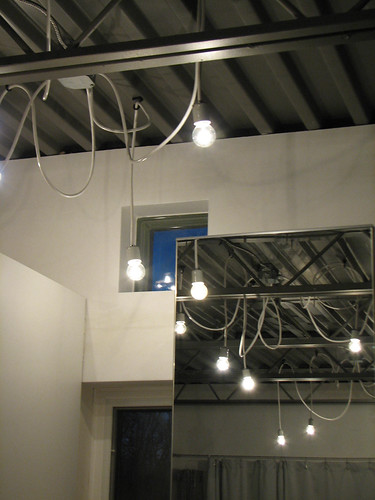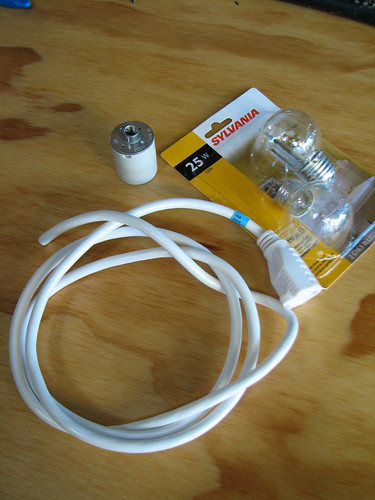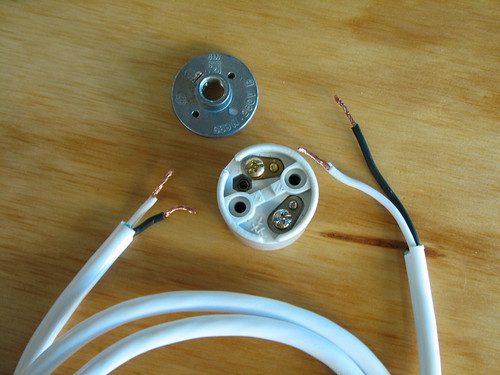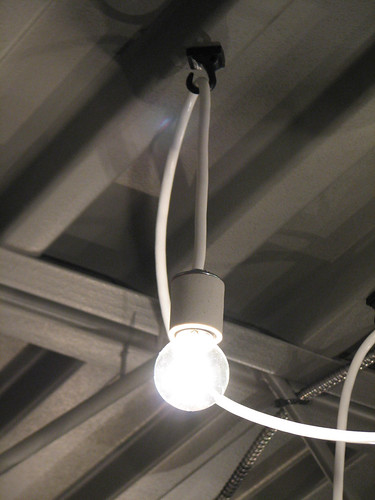Fun with Cord Lights
What does the combination of a hacked up 50 foot extension cord, a few light sockets and some 25 watt bulbs mean for Modern in MN?
Light fixtures for the bedroom, at long last! HURRAY!

The basic components:

As I said, that's just a hunk of extension cord, a porcelain light socket, and some low wattage bulbs. All of this stuff is available at hardware stores and home centers. Or, if you're buying in bulk as I was, you may find it worthwhile to look online for better pricing.

Above is what the inside of the porcelain socket looks like...
Don't forget to put that little metal escutcheon on the cord BEFORE attaching the wires to the screws.
I wired up a bunch of cords in a variety of random lengths. In my case they were getting hardwired into ceiling boxes so I left the opposite end alone, but you could also wire a plug on here to allow them to plug into a receptacle, like this:

And, leveraging the steel-decking-as-ceiling feature that figures so prominently in the decor here at Modern in MN, I found some neato little magnetic hooks to hold each of the cord lights up, making the fixtures endlessly and quickly reconfigurable.

In a regular house I'd either screw a steel plate to the ceiling wherever I wanted to put a cord and magnet, or use a stick-on hook instead. A screw-in cuphook would work too.
Now, if you think I'm crazy and that this is the ugliest answer to lighting you've ever seen, you can stop reading here. If you're someone who is likely to be inspired by this or wishes to have your own fun with cord lights, keep in mind that there are some safety points you'll want to be aware of.
Most importantly, understand the watts/amps equation and figure out how many watts of lamping you'll have in your finished project, making sure that the rating of the circuit you're using can accommodate what you plan to do. BRIEFLY, a standard, 15 amp household circuit is allowed 1440 watts, (but this does not mean that you can or should add 1440 watts of lamping). Also mind that electrical code dictates the number of wires you can have connected inside a box based on box volume and gauge of wire. A basic-ish primer on this can be found here.
When in doubt, consult a professional.
Light fixtures for the bedroom, at long last! HURRAY!

The basic components:

As I said, that's just a hunk of extension cord, a porcelain light socket, and some low wattage bulbs. All of this stuff is available at hardware stores and home centers. Or, if you're buying in bulk as I was, you may find it worthwhile to look online for better pricing.

Above is what the inside of the porcelain socket looks like...
Don't forget to put that little metal escutcheon on the cord BEFORE attaching the wires to the screws.
I wired up a bunch of cords in a variety of random lengths. In my case they were getting hardwired into ceiling boxes so I left the opposite end alone, but you could also wire a plug on here to allow them to plug into a receptacle, like this:

And, leveraging the steel-decking-as-ceiling feature that figures so prominently in the decor here at Modern in MN, I found some neato little magnetic hooks to hold each of the cord lights up, making the fixtures endlessly and quickly reconfigurable.

In a regular house I'd either screw a steel plate to the ceiling wherever I wanted to put a cord and magnet, or use a stick-on hook instead. A screw-in cuphook would work too.
Now, if you think I'm crazy and that this is the ugliest answer to lighting you've ever seen, you can stop reading here. If you're someone who is likely to be inspired by this or wishes to have your own fun with cord lights, keep in mind that there are some safety points you'll want to be aware of.
Most importantly, understand the watts/amps equation and figure out how many watts of lamping you'll have in your finished project, making sure that the rating of the circuit you're using can accommodate what you plan to do. BRIEFLY, a standard, 15 amp household circuit is allowed 1440 watts, (but this does not mean that you can or should add 1440 watts of lamping). Also mind that electrical code dictates the number of wires you can have connected inside a box based on box volume and gauge of wire. A basic-ish primer on this can be found here.
When in doubt, consult a professional.


8 Comments:
WOW! LOVE EVERYTHING YOU HAVE DONE! Perfect timing. I need new lighting in my kitchen after an ugly flourescent fixture (thankfully) died. You make things so simple and beautiful.
Very cool light fixture! From the pictures, it looks just right for that space.
yay! new post! looks great.
-- Olga
I really like this. You should consider switching those incandescent bulbs out for some fluorescent ones though - much more efficient.
Well done!
Hey splatgirl,
Do you have any problems with glare from the clear bulbs - especially since your fixture leaves them exposed?
dostoy: yes, I know, naughty me. As soon as some genius invents a fluorescent bulb that delivers something other than that ishy colored light, I'm all over it. Plus, I figure that between hardly ever turning on lights during the day at all and running my errands on foot every single day instead of driving, I'm making up for a little incandescent now and then :)
knutter: I haven't noticed that but I'm not using them for task lighting, either. I think the clear bulbs give a more sparkly or glittery light, but it also seems cleaner and warmer to me. And I much prefer the look of a clear bulb when it's exposed like these.
Hey there. Awesome that you took to the lighting trend I see in scene bars in Chicago. Love it. Question: when you put the copper to the porcelain socket, how tight is the connection??
Working on the exact same thing with a light fixture and I can't get it super tight. Thanks
Or, "scene bars in Chicago" took to my cheap and easy :) I'm pretty sure I haven't been in a "scene bar" for at least a decade and a half.
If you're talking about the wires that make the connection of the cord to the socket, yes, those screws should be snug. Make sure you're making a little "C" with the wire ends and that you hook them around the screw shank in the same direction it turns to tighten.
Thank you, eighth grade electricity class.
Post a Comment
<< Home